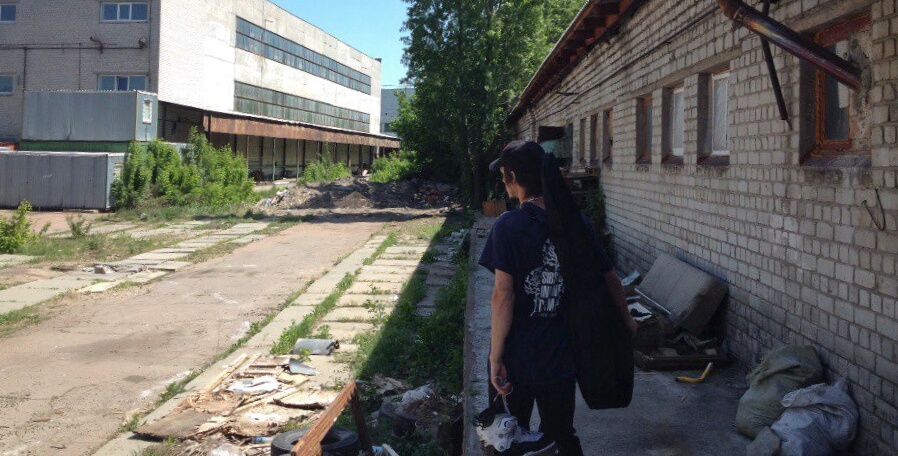INTRODUCTION & INTERVIEW BY DOMINIC ANDERSON
PHOTOS BY IVAN KOVTUN & DANIEL GONCHAROV
We’ve been blessed to witness significant growth within rollerblading. From a number of countries that’ve gained access to more product, more media, and even more sponsorships that weren’t available to them in the past.
Now, with this being said, I really want to draw your attention to a part of the world that doesn’t get to share in many of these things. Yet, has given us just as much talent over the years as anyone else. However, through barriers such as language or even the state of their government, these talents have had quite a difficult time reaching the lot of us whom live elsewhere. It wasn’t until services like YouTube stepped in (which arguably leveled the playing field) that these guys saw the exposure they deserve. Of all countries represented at contests in the United States, theirs’ has been represented the least you could say. With only a select few of its residents ever making it stateside to attend.
That country is Russia, and today I’ll be checking in with Ivan Kovtun & Daniel Goncharov. Both are extremely talented in their own respect, but together, are a force to be reckoned with in front of and now, behind the camera. Their new VOD titled “DUOS” has been available for several weeks now and I consider myself lucky to be able to follow-up it’s review with a look into what life has been like for these two. Many of us are only ever subjected to Russia in a bad light. Through cinema we’ve been led to believe it is unfriendly, or always up to no good. Espionage thrillers (I can’t stress this enough) love to capitalize on its less than favorable history. The late Stanley Kubrick’s “Dr. Strangelove (1964′)” delivered us a boisterous black comedy about it. A “doomsday scenario” that was only possible on the strength of growing tension that had built up between the former Soviet Union and The United States over all these years. Surely, there has to be more to it than that, right? With countless other depictions and even more movies to go on, it’s no wonder people have lost sight of the fact that it’s one of the top three oil producing countries in the world. Or, that its seemingly endless landscape helps to preserve dozens of critically endangered species. Russia has given us many other good deeds too. They’ve given us a wealth of talent, whom all share a deep love for rollerblading. There has been insane stunt skating, incredibly tech skating, and even renowned vert skating that has emerged from Russia in the last few decades. All of which has been enjoyable to see. Year after year, we’ve been given bits & pieces. Like, being handed a matryoshka doll for the first time. You open this doll to discover that just beneath its surface, there are now many others waiting to be found. Each revealing that if you’re curiosity isn’t piqued, then it will be by the time you realize there’s another doll nesting just inside the one you’ve now opened. It’s the gift that keeps on giving, and we at Be-Mag are humbled by the opportunity to give something back.
I’ve kept in contact with Ivan and Daniel. Between time zones and language barriers, the three of us have been piecing this together. And we’re proud to say that today, we’re going to cut through some clichés. Possibly break a few stereotypes, and while we’re at it, we’re going to have a good old’ fashioned chat about rollerblading too.
Ivan. Daniel. Welcome to Be-Mag! Thank you both for taking time to speak with me today. With all the work you guys have been putting in lately, I feel as though this has been a long time coming. Could you both please introduce yourselves. How old are you? And who are your current sponsors?
Dany: Hi, I’m Daniil Goncharov (Dany Mansky). I am 29yrs old. I’m an AM for USD. I have product support from Rollerclub and my sewing art workshop, Coyote Artifacts.
Ivan: Hi, my name is Ivan Kovtun. I’m also 29yrs old. Currently, I don’t have any sponsorship. But there has been long time support from the Moscow skate shop, Rollerclub. They give me skates, and I am grateful to them for this.
How did you guys get into rollerblading?
Ivan: The first time I went skating was in 1999, in Germany. I was given a pair of boots. I learned to ride and jump well. Then, I stopped skating. In 2006, I decided to buy my first pair of aggressive skates and began to learn tricks.
Dany: I was interested in the release of a Russian program on extreme sports. The issue was dedicated to a meeting with Evgeny Leonov. Thanks to my parents, I’d bought regular roller skates. I didn’t know the difference at the time. And only after 2 years, did I have my first aggressive skates.
Evgeny is a living legend. He’s the first name on a long list of Russians who’ve held it down over the years. Do you guys get to catch up with him at all? Is he still skating?
Dany: Evgeniy Leonov is a historical person for Russian rollerblading. He is an active member of the panel of judges at ALL of the main contests in Russia. At these same contests, he skates and performs powerful tricks just like before.

Wow! That’s amazing. I can only imagine how cool it is to watch him skate in person. Speaking of footage, there aren’t many productions that have come from Russia over the years. Though, there have been clips from Russians featured in full-length videos such as Be-Mag’s “Cities Relinquished” dating back to the early 2000’s. Aside from a few clips here and there, how does it feel to produce a VOD from start to finish, that represents Russia all by itself?
Dany: This was our first project, which lasted about nine months. In the creation of which, we sought to show the maximum of our skills at that moment. Skating. Shooting. Editing. Music, and Content Management. Of course, it’s cool to feel you have fulfilled the goal. That the efforts and work have been embodied in the assembled object. Which we can safely share.
Ivan: For me, I can only say that shooting a VOD video, is an interesting experience.
A number of us remember edits from SKATERS.RU in the past, but how many active skate scenes are there in Russia at the moment? Which cities are they in?
Ivan: It’s hard to answer this question. I can confidently say, that riders are gradually disappearing. No one is skating in neighboring cities. There are very few young skaters in Russia, and it is unknown how long they will be engaged for.
Dany: Each city has their own blade life. I don’t know anything about many of them. The most active for sure? You could say that we are, Belgorod. As well as Krasnoyarsk, Moscow, St. Petersburg, Novosibirsk, and Tyumen. If we’re talking about skate schools, then those would be in Krasnoyarsk, Sochi, and St. Petersburg.
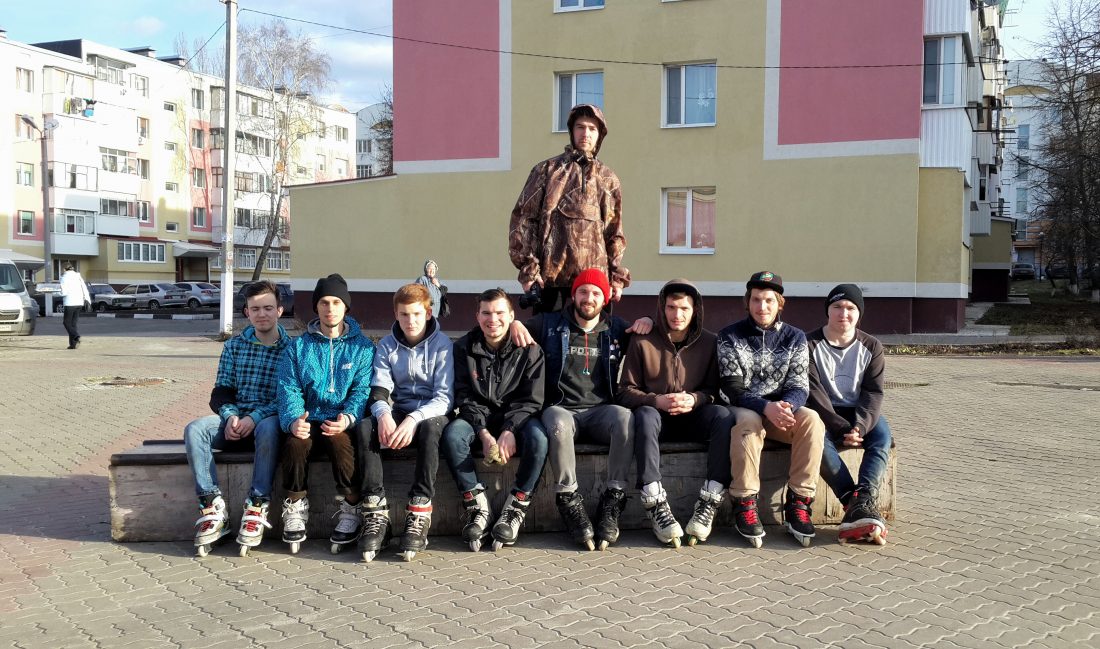

Those cities are far away from Belgorod, which is fairly southwest in comparison to larger areas such as Moscow. It rests on the border of Ukraine. You guys frequently traveled to the Ukrainian capital of Kiev, to film for rollerblading. Since Ukraine is so close to your city, how often do you get to film with other skaters in cities like Moscow or St. Petersburg?
Ivan: Actually, we went to Ukraine for a contest. Then, we stayed there to work. At the same time, we skated and filmed videos. We usually go to contests in Moscow, but we rarely go there to film videos.
Dany: I can’t say that this happens often. This mainly happens on the dates of a competition. In May, AZ Picnic. And in August/September, for Moscow S3T Finals. I was in St. Petersburg once in 2015’. Since then, I have not been there.
Street skating can be tough almost anywhere in the world. Especially when trying to film at certain spots. How strict are the authorities on street skating in Russia? What are the consequences for street skating if you are “kicked out” of a spot?
Ivan: In our city, this is very difficult. Many tricks were never completed due to the fact that pedestrians interfered with us. We are the only bladers in the city. No one understands what we are doing. Therefore, they are trying to stop us. Not so many people like skating.
Dany: There were a lot of misunderstandings. Our older generation calls it “childhood” if you skate on anything. They may say to you “When you grow up? Do you grow up”? This is the shorthand view. Basically, this is swearing and conflicts with the ordinary residents. But it is also joyful when there are positive-minded people. Special gratitude and respect to them.
You guys are right. A lot of people don’t understand what we’re doing. That’s one thing that is universal no matter where you are. We get plenty of that in the U.S. too. It’s not often you come across positive-minded people though, I agree. Much respect to them.
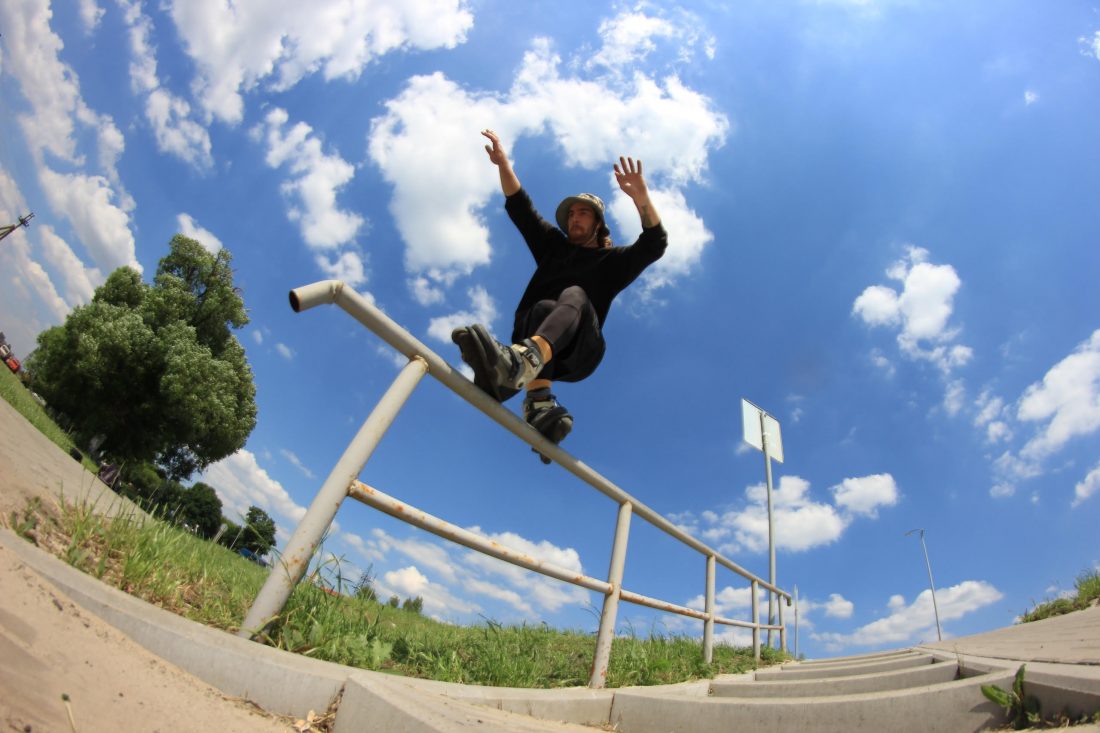
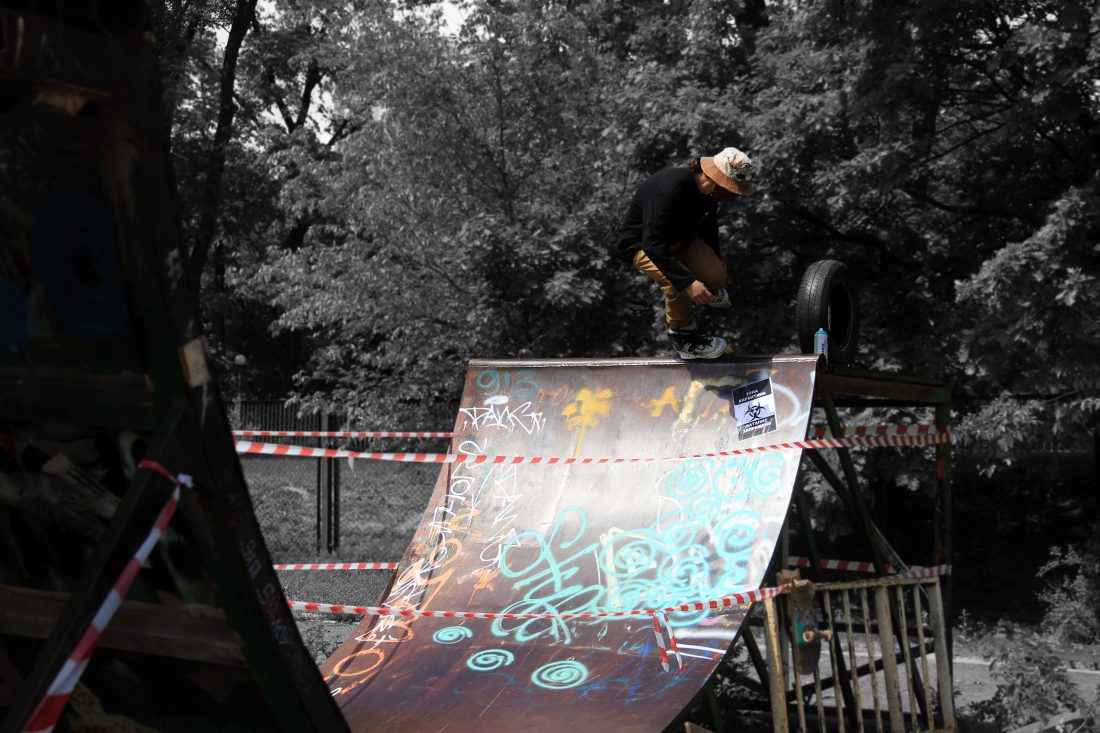
So, Ivan – I’m told that you lived in China for a while. Can you tell us what life was like for you during that time? When were you there? And why?
Ivan: In 2013 I went to live and work in Zhuhai, near Hong Kong, in the Guangdong province. It was a contract job, skating at an amusement park. Life there was fun and carefree. I miss it.
That’s a very unique experience, getting to work at a theme park, demo, or event like that. I feel this is where showcasing rollerblading to the public, can become an honor. And at that point, you’re getting paid to rollerblade every day. So, how did you get a contract to work at an amusement park in China?
Ivan: We got the contract almost by accident. Through acquaintances. At that time, few people knew about this type of work. Therefore, there weren’t too many who wished for it. And I am a fan of going somewhere. Perhaps to represent rollerblading, it is an honor, but we rode in suits and didn’t show many tricks. Although when we went there, I thought there would be much more skating in the park, but work is work.
No matter how carefree that is, you’re still getting paid to showcase the sport, which is rare. That’s an accomplishment in itself.

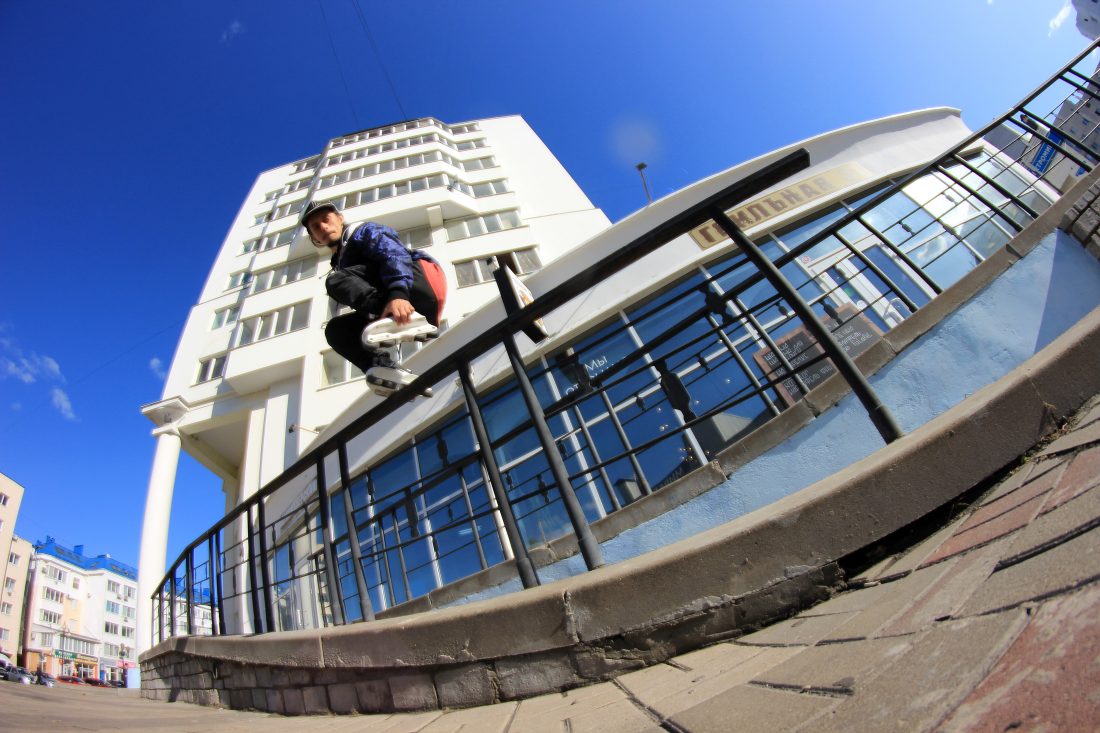
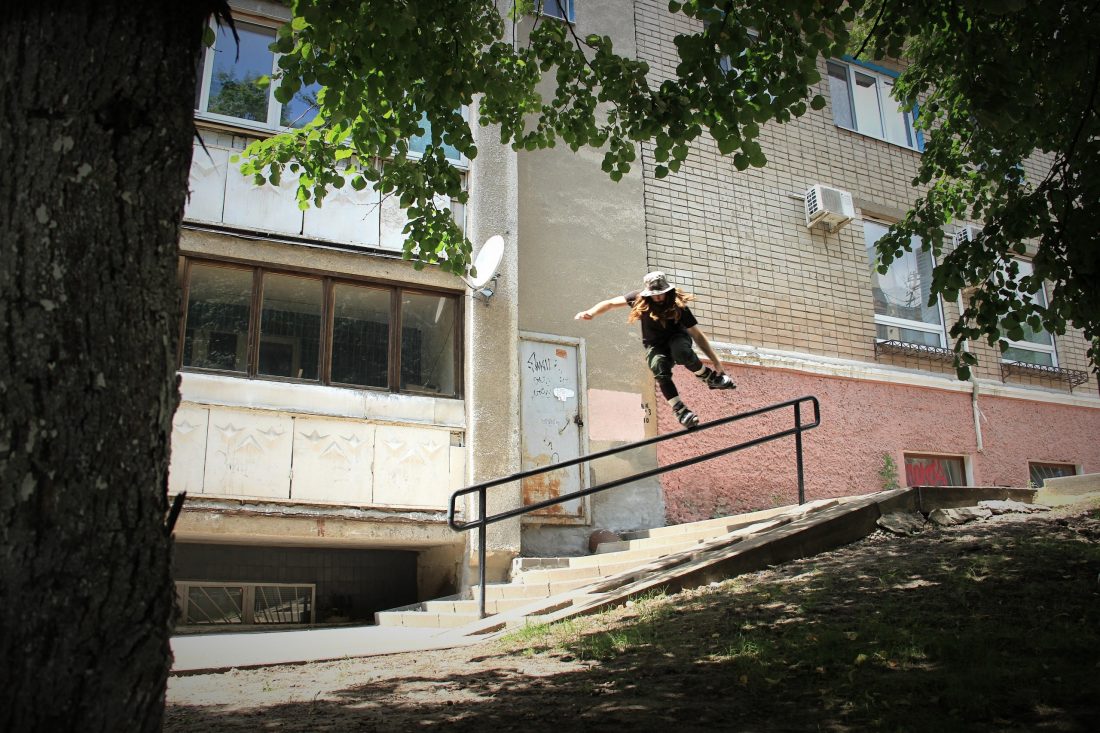
Daniel – I heard that you were part of a band that travelled from Russia to Chicago, Illinois for five months. Can you tell us about your experience coming to the United States at that time? Did you get to do any skating inside of the U.S. while you were here?
Dany: I began learning to play the guitar in 2014. In 2016, my friends from the group About: Blank invited me to go to America. It’s worth pointing out that this trip was like a version of the movie “The Pursuit of Happiness” with Will Smith. They worked part-time at construction sites. We all lived together and the guys tried to find opportunities for us to perform. Performances didn’t happen in their entirety. But there were several times we performed as part of the local band “The Hacky Turtles” and helped to shoot one clip for The Hacky Turtles – Compost (Official Music Video).
I also worked on construction work, went to blade in my free time, bought a guitar and also learned to play. I helped About: Blank with two videos for the song’s About:Blank – Faith (Official Music Video) & About: Blank – Haters Gonna Hate Us (Official Music Video).
It was a very eventful story. Once, I went to a skatepark in the evening and stumbled on a small ledge of a barbershop. I skated fast, listening to music. Blissed out to the fullest. I’d fallen so hard on my side that I injured my shoulder. For a month I didn’t skate and it was hard to work. My excitement was that my passport was expiring and I needed to order a new one, and had to go to Washington to get it. It was a strong test, but how cool it was even with these difficulties. Upon returning home to Belgorod, I edited this video: The Pursuit of Happyness – Daniel Goncharov with my guitar vibes.
We’ve seen clips of you in contests like Red Jam, AZ Picnic, and Battle for Gold. You seem to do very well in both park and street. Are there any contests that you would like to skate in that you have not been able to make it to over the years?
Dany: Thank you. Yes. I try to quickly get used to the style of skating in a park, in bowls, as much as mind and body allow. I have been to Winterclash twice. So, I want to participate there again, to see what I can do now. No doubt it would be great to skate at The Blading Cup, I really like these lines. I don’t really like big parks with big bowls because I don’t know how to skate there. When you go around and around in circles, you feel like you’re just a coyote running through the desert.
The park footage from you guys on the internet is mostly filmed at the same skatepark. There is a structure in the center of the park that looks out of place and the stairs go up really high. What is the story behind this skatepark? Is this the only park you have in Belgorod to skate?
Dany: At the moment, this is the only skatepark in Belgorod. This place was a roller rink area in the 2000’s. Previously, there were discos. For a long time, it was empty, but we went to skate at self-made (D.I.Y.) figures or obstacles that were there, since there is perfect coating on the ground. For several years we have had this skatepark. We sometimes use the structure as a filming tower.
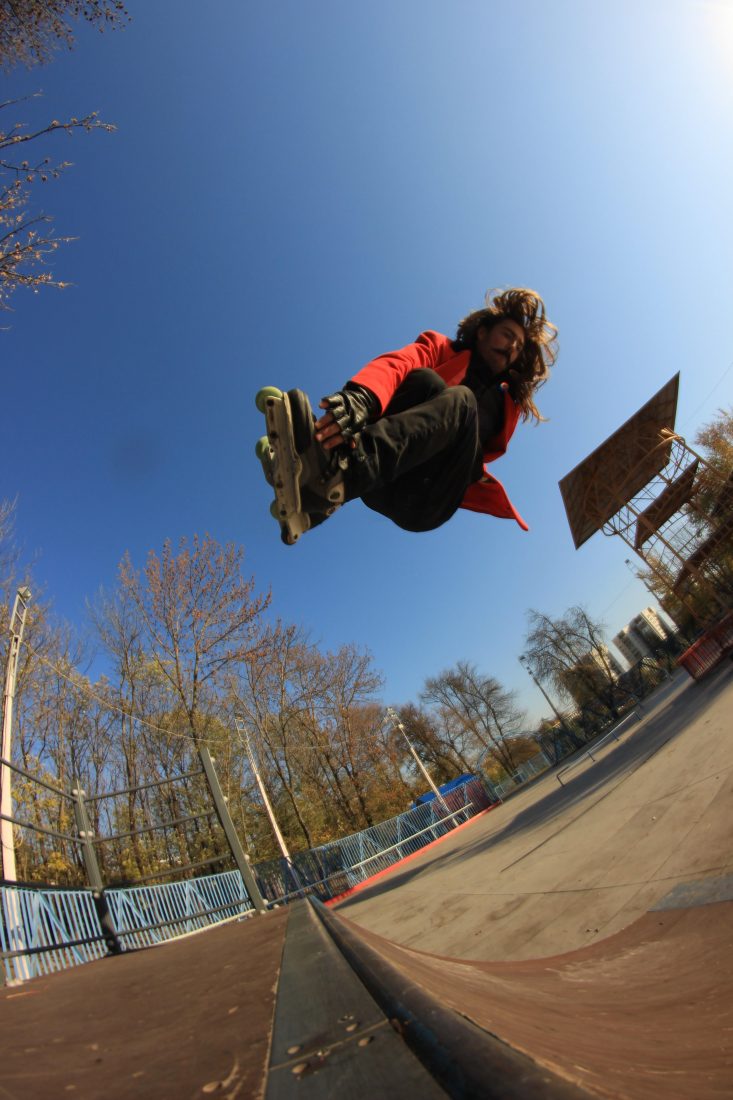
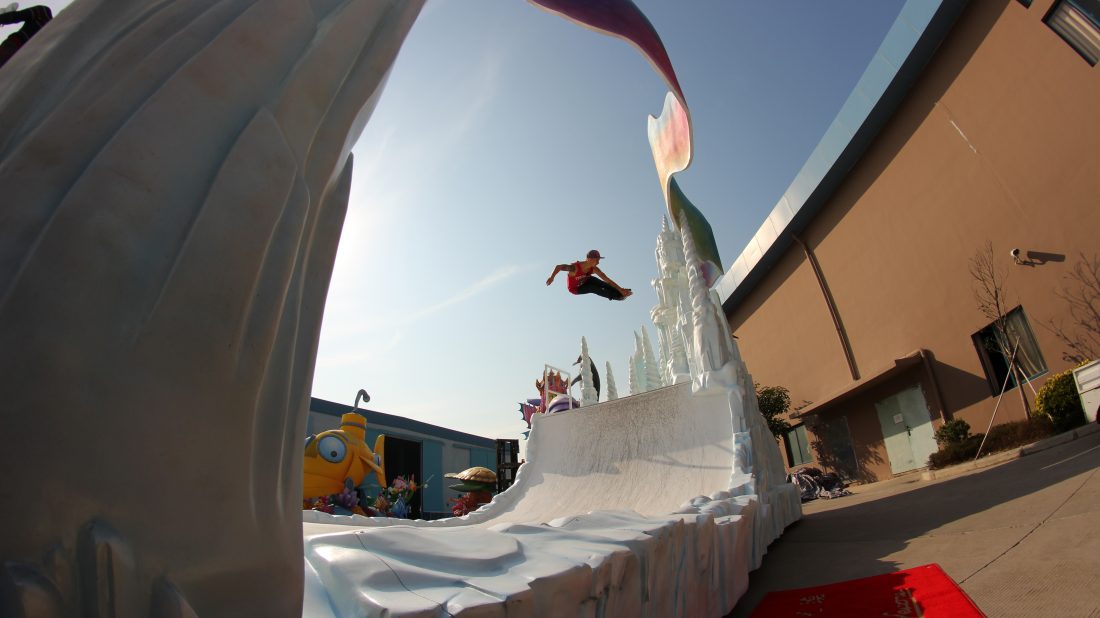
For many of us, videos like Mindgame’s “Brain Fear Gone”, 4×4’s “Leading The Blind”, and Dave Paine’s “Videogroove” series are all considered videos that’ve changed our lives. Are there any videos that you feel the same way about?
Ivan: For me it was Mindgame’s “BANG!”. In every sense, it was unusual. Tricks. Music, and the idea of the film. Maybe I would be inspired by something else, but for me “BANG!” was the very first thing I watched. It is impossible to be inspired all the time by just one film. Everything develops. Quite a lot of worthy films came from those since.
Dany: Of course. The Vibralux section from “KFC 3” with Chris Farmer, Chris Haffey, and Alex Broskow. This was the first video that someone from us downloaded from the internet. Probably each of us watched it every day. A very strong impression was given by the ONE Video. Which we watched in a cinema in Kiev, after the One WithMe S3T contest. Killerboots, Game Theory, and Vine St. All profiles from Chris Haffey or Franky Morales. From the more modern videos, I was very motivated by The Cayenne Project films.
Daniel – In the trailer for DUOS, there is a clip where you fall from nearly two meters to the ground. Then, there is an image of an X-Ray with a gnarly fracture (or puncture?) in the side of the face. Was this X-Ray from that fall, and what’s the story behind this?
Dany: The story with this happened in the previous season. It was a beautiful day, we went to the next shoot, I noticed this spot a long time ago. I thought it would be easier, and could not cope with the sensations, my legs were tangled. I remember it in a second, when I realized that I was hooked, my body seemed to turn off. Then, I woke up. I did not immediately understand what happened. As if I were not at the time of the fall. I got concussions and a bruised shoulder joint, but I healed quickly enough, like Wolverine ha ha.
I want to give our readers a sense of what it’s like to live in Russia, economically. For example; In Honduras, one ($1) is equal to having roughly twenty-one ($21) dollars. That’s a big difference. Can you tell our readers how the American dollar compares to rubles (RUB) in Russia?
Dany: Speaking about the economy, it’s worth dividing the consideration of this issue into Russia and Moscow. Moscow has its own life, the economic level there is different. In my environment, in Belgorod; the average income per month is 20-25 thousand rubles (RUB). At the current rate, this is equal to $300-350 (USD) per month, of work. Buying a package of products for the whole family for just a day or two is like spending $10-20. Going to a bar with friends, getting drinks and snacks is like spending $10-20. Going to Moscow and back, $50.
If that were the case here, it would cripple our economy. That has to have a sore effect on the population there. With being professional skaters, do you find that people treat you guys differently in areas of Russia where skating could be frowned on?
Dany: Of course. As I said, many older people in Russia call this “childhood”. If someone respects you, that someone is neutral. I will say one thing, the difference in human behavior and attitude towards us. In China, people were very friendly. There were cases where they wanted to treat us with cans of cola. They just got together and looked, or they wanted to take a picture. In Chicago, we came with my friend Eddie to an interesting design in the business center. The scene from “The Lake House” where Keanu Reeves crashes at the end. The guard allowed us to try one attempt more, although skating is of course forbidden there.
There are many kinds of people in Russia, but there are often people who are offended and dissatisfied with life who worry about the paint on the pipe more than someone else’s life aspiration.
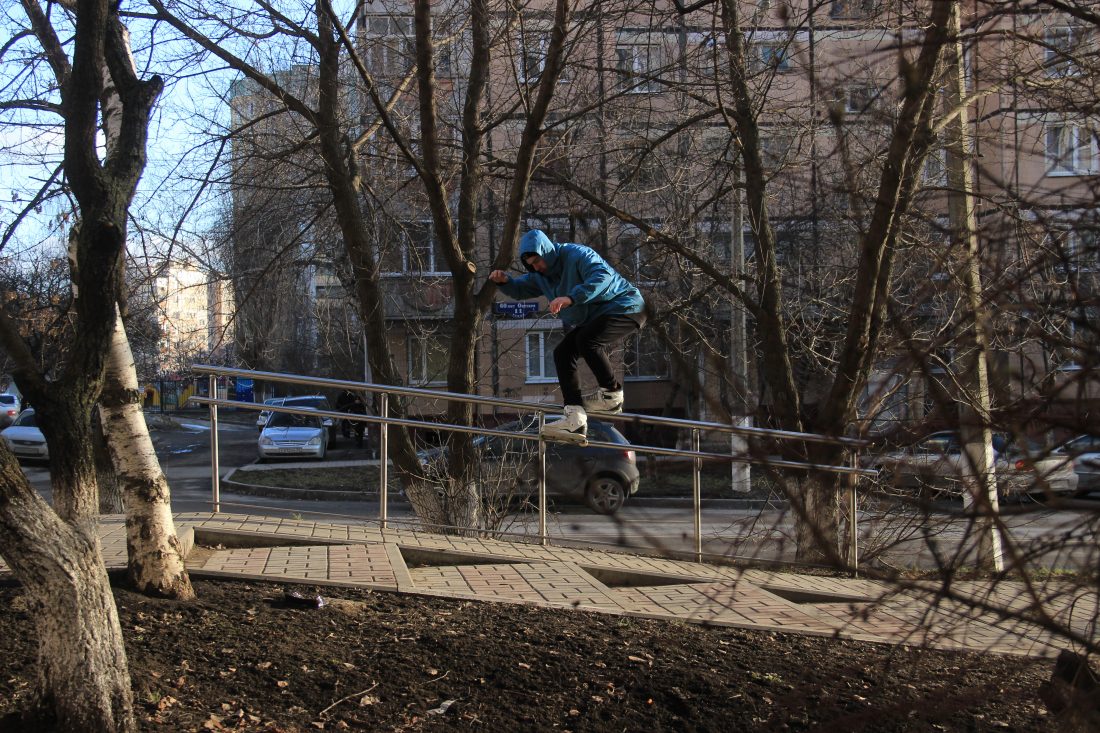
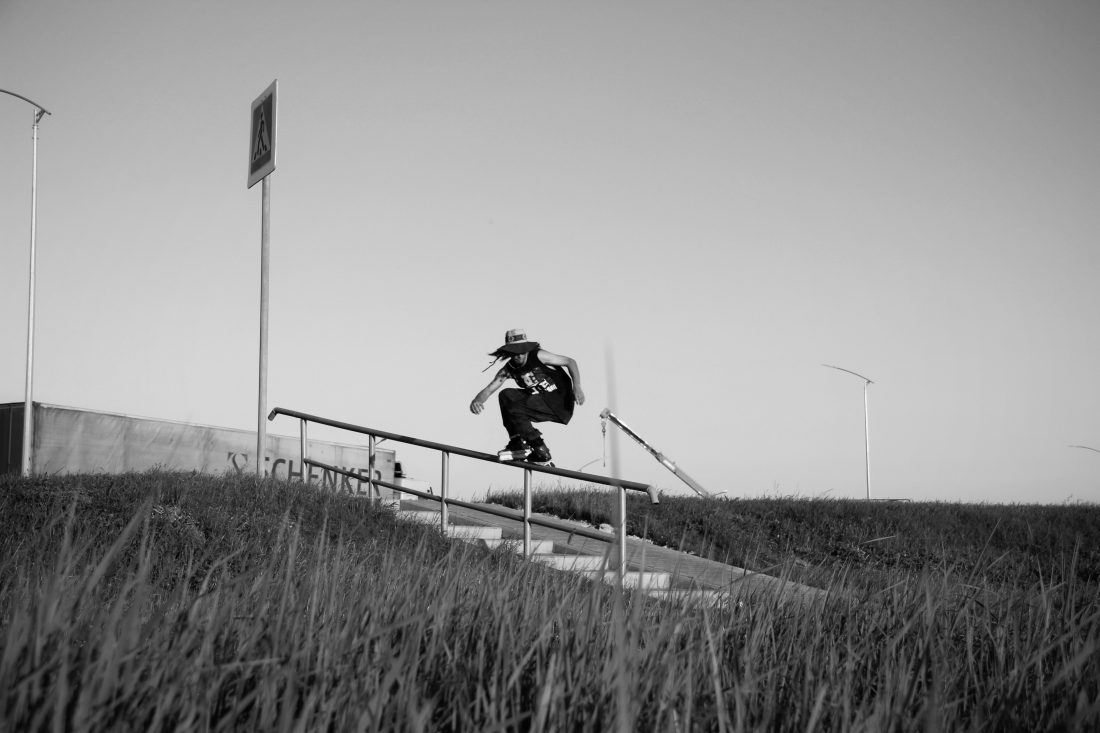
I can relate to that. Many of our readers can relate to that too.
Ivan: The attitude towards me is the same everywhere. In addition, I do not position myself as a pro. I don’t quite understand where it starts and where it ends. At what point can I be considered pro?
Most people would consider pro as having their name on a product and/or receiving a paycheck just to go skate. Generally, for your name to sell pro skates, frames or wheels. But there are plenty of people who get paid to skate without their name on products. For a while, you both were getting paid to skate at an amusement park. So, a lot of us would consider you both to be pro. Especially when you look at the high level of difficulty in the tricks you perform. It’s a matter of perspective, I guess”.
Ivan: We just had to ride and smile at the crowd. There was a guy on our team who only knew basic grinds. Can we call him a pro? No. There are quite a lot of riders who never got a pro model. For me, Mark Wojda or Jeremy Spira are more like a pro.
I see your point. They’re both regarded as pro for many of us too. While we’re on the subject, is there anyone you feel should have gotten a pro skate, but hasn’t?
Ivan: A lot of bladers. Do you know Michael Froemling, Yair Viner, Willie Trebach or Jake Dotson?
Everyone finds themselves in a different situation. Many riders give all their best. Winning contests and making content. It can be said to do free advertising, with nothing in return.
Many of our core readers agree with you. There’s been a lot of that “free advertising” going on lately. It’s only fair that good efforts, receive good compensation. Expenses behind rollerblading can add up quick with travel, lodging, and even fines that weigh heavy. Have either of you ever been given a ticket for “destruction of property” or “trespassing”?
Dany: During all the shootings of DUOS, it was unpleasant for me for only one piece of fallen off plaster. All that was on this path was swearing with the residents. Although, we try to be calm and communicate adequately. But I agree with some of them that we (I speak for everyone who skates something) sometimes carry out our ideas and leave behind some dirt or traces of paraffin. Both sides should be more understanding. For example: people come up to you and say to you that you are breaking something. Wait a minute. First of all, I am not interested in breaking anything. I feel how the figure feels and other aspects. And some people, as if with a veil over their eyes, are coming at you. Just to forbid you something and pour out their negativity for doing something that is not in their range of views.
Ivan: The police reaction is more adequate than that of those pedestrians. In my school years, people would pounce you with their fists. Once, I was hit in the face by some unknown man because on a different day, he saw us riding on the railing. Now, they can hinder us, but they are afraid to touch us.
A total stranger hit you in the face for skating a handrail? That’s pretty intense. I know it may have been an issue that you were skating there, but this person struck first. How did you handle this situation?
Ivan: I could not cope. I was just a kid (a schoolboy). This man was with his wife and daughter. At first, he spoke to me. Then, he suddenly hit me on the head when his wife had turned away. I fell down and did not even understand what happened. Then, his wife said “let’s go” and they disappeared.
Of course, you should not judge everyone by only one person. We just live in a small city. In Moscow everyone is in a hurry. There are a lot of visitors to Moscow and they don’t care what you do or what they are doing. It is huge. You can go anywhere there”.
With over 12 million people in the city of Moscow, I can see how difficult that could make things.

Daniel – Let’s talk about Coyote Artifacts. You have a great interest in sewing. In the “Bonus” for DUOS you both put on costumes and created a comical alternate reality where superhero’s wear rollerblades. Can you tell us about the things you hope to achieve with your sewing workshop? How you got into sewing? and what exactly is in store for Coyote Artifacts in the future?
Dany: I will try as short as possible about this, because here I can be very verbose. If suddenly someone thinks that I made the costumes? Ha ha. No, they were lent to us. In one of the first stages–I believe this is a manifestation of genes, because my father is a tailor for over 30 years. I love video games very much, so my desire is to correlate Coyote Artifact products with imagery of “pumped up” gear. Giving you certain enhancements to your abilities. As many people know, at one of the levels of the universe, everything is a stream of energies. So, the real question is: what kind of energy does everyone radiate into the world through his thoughts or actions?
Each lot is as my own achievement, the achievement of my own being. It’s like a kind of artifact that I found while playing in my life. On the road, artifacts just do not roll, agree? Many of them took many hours of work, both external and internal. Restructuring their own beliefs, meeting their fears, dead ends of knowledge and much more. Therefore, I want to present Coyote Artifacts as objects of achievement. And the history of their creation fills things with a vector in the direction of better human qualities and discoveries. Understanding and disclosing love & wealth through the owner’s actions, through everyday movements.
What will happen in the future? There are many development paths, and I want to go through each of them. Recently, I began to like the theme of customization. I make each lot personally. So far, no mass production. I also do all of the digital manipulations.


That’s very impressive, and your pieces are amazing. You guys have proven to have many other talents. Despite this, there are still misconceptions (or false stories) about Russia. Many people believe that it is just not a nice place to be. Could either of you share with us your thoughts on why the rest of the world have been led to believe those things about your country?
Ivan: I have not heard of these. But a subscriber from Iran recently asked, is it true that Putin let out 800 lions on the street so that people stayed at home during the pandemic? And after that, the subscriber sent fake news from the T.V.
Before, every country praised themselves on T.V. and spoke badly about the other countries. But now, everyone is on the internet. You yourself can find out any question and make your own conclusion about the country.
That’s true. The information is out there for anyone to find on their own, if they like. Not everyone is willing to do the research, though. Some will likely take the words of others, before facing facts. With the way the media is now, it can be a toss-up.
Dany: I would say this, there are parts of behavior that for some reason are considered Russian, although it is universal. Ignorance and savagery, we call it Bydlo (I will use this slang word below). In many cities, such behavior was formed from different historical reasons. Some tourists from Russia showed themselves like this abroad. The human brain works so that it quickly forms connections between images, actions, and descriptions. I will say that the population of Bydlo were enough and is enough, but personally, I don’t attribute this like “Russian”. It is Bydlo, and how we used to say: Bydlo is everywhere Bydlo, even in Africa, even in Antarctica. Russia is a huge beautiful country with beautiful landscapes. Huge mysterious forests and mountains. Cities with their own stories, and there are a lot of good people there too.
I would distribute humanity as a whole like this; America is the mind. France & Italy are the love, pleasure, and self-acceptance. Eastern countries are the wisdom & knowledge. Asian countries are probably steadfast, with a subtle understanding of honor. Africa and South America are the rhythm, and Russia is the soul. Though I would attribute all BYDLO to the category of a wandering soul. Which will not find the opportunity to accept and understand themselves, receiving bad energy from others by such behavior and violence.
I like that. The idea of each country representing a positive emotion or character trait. That’s a nice way of putting it.
Can you guys tell us who your influences are from rollerblading, or sports outside of rollerblading? You guys are both known for putting in work when it’s needed, but you still manage to have fun while you’re at it. So, where do you get your inspiration from?
Dany: I’ve always enjoyed a skate session on a regular training tube (practice rail). Carefree sorting out tricks, trying something new, without serious risks. Personally, I am most likely motivated by my own skating, growth tracking, understanding that there is already so much in this life, so I should go further. But it also happens that I don’t feel desires to skate. Interest is greatly heated up by interesting spots, and interesting park features, or a new pair of skates. When all the tricks need to be repeated again, because the sensation from this seems new, not completed.
Ivan: Inspiration is a very strong word for me. The older I get, the less something inspires me. I can be surprised at something, but not very much and not for long. I can be inspired by anything. Cinema. Art. Sports, and so on. Further, music helps me for something new.
Ivan – Many of our readers are thinking it, so I’m just going to ask. There have been an increasing number of online “Games of B.L.A.D.E” lately. Have you given any thought into collaborating with Eugen Enin to entertain the community?
Ivan: I often see such comments. This is interesting, but no. I never thought about it. The game should be held on equal terms. On the same spot. I think this game should not be called “B.L.A.D.E” but instead, should last up to 50 points. I think it will be fast.
Well, however the game is played, I think we’d all like to watch that go down. Whether its 50 points or five letters, a lot of folks seem to be excited at the possibility of watching you go toe-to-toe with Eugen, at any spot. It would be a highlight for sure.

We understand that it’s difficult to promote your skating and your efforts to the community from inside such a small city. Especially amidst the ongoing COVID-19 pandemic, with everyone staying indoors now. How has social media helped you guys maintain a presence with everyone around the world throughout all of this? And for those who aren’t following you guys on social media, what would you suggest to the community to help other skaters build an online following of their own?
Ivan: This situation did not affect me in any way. In many cities there is complete madness. In our city they did not introduce harsh measures. Therefore, I am glad to be home. Only cafes and other public places have closed, but you can walk. You need to wear a mask. All this time I skated, and Daniel helped to shoot a new video “Stuff 100.
Ivan Kovtun’s “Stuff 100” profile
Madness is right. Panic rode a wave up & down for many weeks. Then, it stayed up, with no hope of coming down. Businesses are slowly opening again, but much of that panic is still with everyone.
Dany: Undoubtedly, the internet is a window to the world, especially today. Personally, my mode of life hasn’t changed. We train in a skate park, and I work at home in the workshop.
I say this to everyone, to myself in the first place: each of us is inherent in various human manifestations. Some of them are destructive. It happens that someone’s movements, aspirations, and achievements, by other people, are perceived as a form of defeat for them. If one wins, the other loses. We better share each other’s successes and share sincerely, not succumbing to the destructive manifestations of the human ego. Probably, these mechanisms work both with personal interaction of people, and online.
First of all, all riders should skate. Grow their professionalism. Develop their artistic look. Develop their own style, which means being yourself. To learn to communicate with people, both good and evil-minded (in a sense, every hater is a part of the spot). To make high-quality material, develop your content. Every day to learn and be open to opportunities to learn something, to review something, or to understand something.
Well, we think it is great you guys have safely managed to keep filming during this global pandemic. A lot of us haven’t been as lucky. Continuing to skate, film, and develop an online presence isn’t as easy as one would think. So, being mindful of opportunities, and knowing precisely when to capitalize on them, can be just as valuable as the result they produce. You both seem to have a good understanding of these efforts, and the videos you’ve been making lately, really do a good job of showcasing that effort to the community.
You’ve given us a trove of information today, and it’s sincerely nice to get to know you guys in the process. We’re thankful for you guys and appreciate the time you’ve spent with us to make this interview happen. It’s been another great experience for all of us here at Be-Mag and we hope that it’ll open up many more doors for you two as well.
That’s going to wrap things up for now. Again, it’s been great catching up with you guys. Would either of you like to “shout out” to anyone who has helped you out along the way? Anyone at all?
Ivan: You know, Dominic. My mom absolutely doesn’t like the fact that I skate. She would rather see me in a suit or formal clothing. She wanted me to become a teacher. Despite this, she has always supported me. This continues to this day. I do want to mention one person though, Boris Gaisner “aka” Plastik Mag. He has greatly influenced the development of blading in Russia. He spends his energy on conducting contests and developing media, without any benefit to himself. He also connected me with the Rollerclub. I also want to thank Eugen Enin. He is the very first pro skater to start supporting me. I can list people endlessly. A lot of people have influenced my development and I am grateful to everyone for that, including you.

Dany: We want to express our gratitude to our families and friends for their support, for their indirect participation. Thanks to the rollerblading community for information support, and posts. Thanks to the Rollerclub and Victor Bayramov for the sponsorship. Many thanks to Boris Gaisner for information support, and for organizing the premiere of DUOS in Moscow. Thanks to all the guys who follow us, and share our material. Many thanks to everyone who bought DUOS, thereby supporting our work. Many thanks to the people who have bought things from Coyote Artifacts. I wish for them to find new skills in themselves day after day. To develop and strengthen what they have already found. Thanks also to those conflicting people who kicked us out from spots. Sometimes this can be attributed to the category of “being saved from something”. Many thanks to Dominic Anderson, Kevin Little and Be-Mag. I wish you all success. Excellent, pleasant skating sessions. Personal victories, discoveries, and achievements.

From Russia, with Love.
YOUR FAVORITE PRODUCTS BY YOUR FAVORITE COMPANIES. SUPPORT BE-MAG WITH EVERY PURCHASE.






